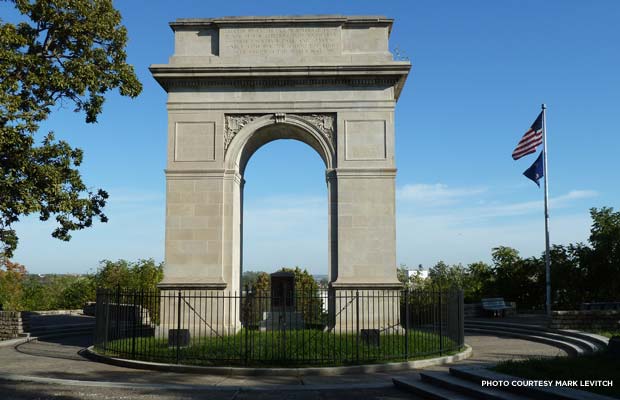Written by Mark Levitch, Art Historian and Founder, World War I Memorial Inventory Project

Architect John LeRoy Marshall designed the Rosedale World War I Memorial Arch (1924) in Rosedale, Kansas.
World War I, which started one hundred years ago this month, is generally considered one of America’s forgotten wars. But the war’s ubiquitous memorials -- perhaps more than for any other U.S. conflict -- beg to differ.
World War I: What’s the Big Deal?
Why, people ask, are there so many World War I memorials? The short answer is because the war was without precedent in its weaponry, scope, and carnage; because the U.S., though it joined the conflict in 1917, played a decisive role in securing allied victory; because the entire nation -- north, south, east, west; urbanites and farmers; men and women; African-Americans, Native Americans, and immigrants -- participated on the home front and/or the fighting front; and because the war’s toll was a staggering 116,000 American dead with twice that number wounded.
After the 1918 Armistice, communities at all levels -- towns, neighborhoods, cities, counties, states, and territories -- felt compelled to mark the conflict, as did clubs, colleges, churches, synagogues, businesses, fraternal organizations, and veterans groups. As a result, thousands of World War I memorials, from simple honor rolls to doughboy sculptures to grandiose architectural ensembles, blanket the country.
Hillsdale High School World War I Memorial Plaque (1924) in Montclair, New Jersey
All of these memorials, big and small, mass-produced or designed by renowned artists and architects, are potential prisms through which the war can again be made vital. Each has a story. But sadly, these stories have been largely forgotten. And while many memorials are carefully tended, others have fallen into disrepair, or have even been lost altogether, through neglect, vandalism, or theft.
The WWI centennial offers a timely opportunity to raise public awareness about the importance of World War I memorials to the country’s cultural, historical, and physical landscape, and to help ensure their long-term preservation.
Launching an Inventory
The first step in the memorials’ preservation -- and in recovering their stories -- is to document them. This, in the simplest terms, is the goal of the World War I Memorial Inventory Project.
The project began informally about six years ago, after I could not locate an intriguing-sounding monument that the French government had reportedly given the U.S. government in the late 1920s. (I still haven’t found it, by the way.) I then just started keeping an eye out for memorials, especially when traveling. I was stunned by the number of memorials and their variety, and often distressed at their condition.
York County World War I Fairground Memorial (1921) in York, Pennsylvania
After smacking myself on the head for not realizing sooner -- as an art historian and lifelong student of the war -- what an incredible resource and object of study these memorials could be, I started doing more research into the memorials while also looking into whether it might be feasible to conduct a crowd-sourced inventory.
“Is that a World War I Memorial?â€
World War I memorials assume myriad forms, some more readily identifiable than others. For example, doughboy sculptures (“doughboy†was a term of endearment for U.S. soldiers during the war) are World War I-specific and ubiquitous. Most are celebratory, but several, such as Karl Ilava’s doughboy sculpture in Gloversville, New York, allude to the war’s cost.
Karl Ilava's "The Thinking Doughboy" (1923) in Gloversville, New York
Most prevalent are simple honor rolls that list the names either of all who served or only those who died. Newly prominent after World War I -- a riposte to the anonymity of modern war -- they are found on town greens, affixed to court houses, or hung in high schools, businesses, and houses of worship, often effectively hiding in plain sight.
Other common World War I memorial forms include allegorical sculpture, such as Daniel Chester French’s "Victory" figure atop the First Division Monument in Washington, D.C.; neo-classical structures, including obelisks, arches, and columned temples; and memorial trees, parks, fountains, gates, flagstaffs, murals, and stained glass windows.
Living Memorials
Perhaps the most innovative memorial form to arise in force after the war was the so-called “living memorial†-- a commemorative structure that married the desire to remember soldiers’ service and sacrifice with a utilitarian function.
Living memorials took many forms, including a variety of buildings (libraries, hospitals, city halls, community centers, stadiums, dormitories, theaters, auditoriums, etc.), as well as infrastructure projects, such as bridges and tree-lined victory roads. Because they tend to occupy prime locations and are the costliest to keep updated and in good repair, living memorials often face a greater threat of demolition than other memorials.
Waikiki War Memorial Natatorium
This is the unfortunate circumstance facing one of the country’s most significant memorials, the Waikiki War Memorial Natatorium (1927). A unique memorial in the form of an ocean-side swimming pool, the Natatorium was recently added to the list of America’s National Treasures by the National Trust for Historic Preservation.
The signal place of the Natatorium in the realm of U.S. World War I memorials was underscored in a strongly worded letter urging its restoration sent recently by the U.S. World War One Centennial Commission -- the Congressionally mandated body charged with overseeing the country’s commemoration of the centennial of World War I -- to the governor of Hawaii and the mayor of Honolulu: “Thousands of World War I memorials -- many quite magnificent -- were erected across the country in the post-war period, and by any measure the Natatorium ranks among the most significant. It is the exemplar of a World War I ‘living memorial.’â€
The entrance to the Waikiki War Memorial Natatorium
The Commission cautions strongly against taking the unprecedented and irremediable step of demolition, noting that “in no instance that we know of has a state or U.S. territory significantly altered, let alone demolished, its official World War I Memorial.â€
To do so, the letter continues, “would be widely regarded as a gross disservice to the memory of the people for whom the memorial was erected.â€
The Centennial Commission’s letter underscores how important it is to preserve the nation’s World War I memorials. Bearers of history embodied in culturally specific and significant forms, they represent a bond across generations that deserves to be honored.
Act now to convince the city of Honolulu to save its one-of-a-kind living war memorial. Sign the petition today.
The National Trust for Historic Preservation works to save America's historic places. Join us today to help protect the places that matter to you.
Although we're always on the lookout for blog content, we encourage readers to submit story ideas or let us know if you've seen something that might be interesting and engaging for a national audience. Email us at [email protected].







Dennis Skupinski
August 21, 2014
Posted on Michigan’s WW1 Centennial page on facebook.
Gretchen Bohnert
August 21, 2014
impressive work by Marc Levitch
Save the Waikiki memorial
William N Brown
August 22, 2014
If not for the efforts of dedicated historians/activists like Mark Levitch, the US World War I Centennial Commission, the American Battle Monuments Commission and the many journalists and writers who are bringing attention to the Great War and the centennial of WWI, another important period in American history would pass without much recognition.
Bill Brown, President
Association of the Oldest Inhabitants of the District of Columbia, Est. 1865
Brian Adams
August 22, 2014
Preserve & Conserve the Waikiki War Memorial Natatorium!
Joan Lucchesi
August 22, 2014
I know the land in Waikiki is costly BUT so were the lives of the heros that the Natatorium honors. Please save the Waikiki War Memorial.
Robert Shay
August 23, 2014
I plan to stand at this Memorial on the 11th hour of the 11th day of the 11th month this, the centennial year! Who will join me?
Robert Shay, former PH3, USNR-R
1964 to 1970
NAS Sand Point, WA
USS Kitty Hawk
NATTU, NAS Pensacola, FL
USS Ajax
The Reverend Melissa Hall
August 27, 2014
This was a wonderful article. Our church nave and bell tower is a WW1 War memorial dedicated to the 91 Montclair NJ members who served in WW1